Related Research Articles
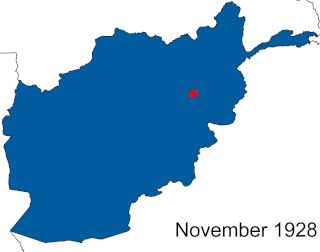
The Afghan Civil War was fought from 14 November 1928 to 13 October 1929. Rebelling, and subsequently governing Saqqawist forces under Habibullāh Kalakāni fought against various opposing tribes and rival monarchs in the Kingdom of Afghanistan, among whom Mohammed Nādir Khān eventually achieved a preponderant role. Despite early successes, such as the capture of Kabul and defeat of Amanullah Khan on 17 January 1929 or the capture of Kandahar on 3 June, the Saqqawists were eventually deposed by anti-Saqqawist forces led by Nadir on 13 October 1929, leading to Nadir's ascension as King of Afghanistan, who ruled until his assassination on 3 November 1933.

Tajikistan harkens to the Samanid Empire (875–999). The Tajik people came under Russian rule in the 1860s. The Basmachi revolt broke out in the wake of the Russian Revolution of 1917 and was quelled in the early 1920s during the Russian Civil War. In 1924 Tajikistan became an Autonomous Soviet Socialist Republics of the Soviet Union, the Tajik ASSR, within Uzbekistan. In 1929 Tajikistan was made one of the component republics of the Soviet Union – Tajik Soviet Socialist Republic – and it kept that status until gaining independence 1991 after the dissolution of the Soviet Union.
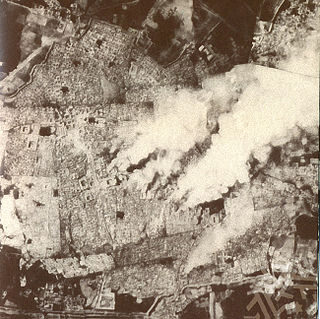
The Basmachi movement was a decentralized movement which undertook a protracted uprising against Russian Imperial and Soviet rule by the Muslim peoples of Central Asia. The movement's roots lay in the anti-conscription violence of 1916 that erupted when the Russian Empire began to draft Muslims for army service during World War I. In the months following the October 1917 Revolution the Bolsheviks seized power in many parts of the Russian Empire and the Russian Civil War began. Turkestani Muslim political movements attempted to form an autonomous government in the city of Kokand, in the Fergana Valley. The Bolsheviks launched an assault on Kokand in February 1918 and carried out a general massacre of up to 25,000 people. The massacre rallied support to the Basmachi movements who waged a guerrilla and conventional war that seized control of large parts of the Fergana Valley and much of Turkestan. The group's notable leaders were Enver Pasha and, later, Ibrahim Bek.

Gharm is a city and jamoat in the Rasht Valley area of central Tajikistan. The population of the town is 9,800.

Habibullāh Kalakāni, also known by his nickname "Bacha-ye Saqao" was a ruler of Afghanistan from 17 January to 13 October 1929, as well as a leader of the Saqqawists. During the Afghan Civil War, he captured vast swathes of Afghanistan and ruled Kabul during what is known in historiography as the "Saqqawist period". He was an ethnic Tajik. No country recognized Kalakani as ruler of Afghanistan.

Ibrahim Bek was the leader of an anti-Soviet group known as the Basmachi. He was a member of the Uzbek Lakai tribe in Eastern Bukhara and led an organized resistance against the Soviet military in the 1920s. A religious conservative and loyal to the ousted Emir of Bukhara he had little dealings with "reformist" basmachi who had jadids in their ranks. He actively fought against Enver Pasha during his brief time in Central Asia. Despite being a good guerrilla leader, Ibrahim was essentially a relic of an older time and was to find his increasingly sophisticated military tactics out of step with the political nature of the Russian Civil War.
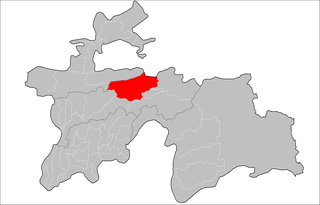
Rasht District is a district in Tajikistan, one of the Districts of Republican Subordination. It lies between the city of Vahdat in the west and Lakhsh District in the east; its southern neighbors are Nurobod, Sangvor, and Tojikobod districts; its northern border runs along the eastern finger of Sughd Region and along the international border with Kyrgyzstan. Its capital is the town Gharm. The population of Rasht District are known as Gharmis. The population of the district is 127,400.
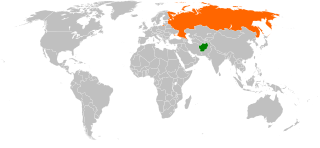
Afghanistan–Russia relations are the relations between the nations of Afghanistan and Russia. These relations are independent of the "Great Game" which consists of Russian–British confrontations over Afghanistan since 1840. On 28 February 1921, Afghanistan and Soviet Russia signed a Friendship Treaty. The Soviet Union was the first country to recognize Afghanistan's independence following the Third Anglo-Afghan War in 1919.
The Gharm Oblast was an oblast in the Tajik Soviet Socialist Republic in the Soviet Union from the 1920s to 1955. Its capital was Gharm. The population of Gharm were known as Gharmis, a term still used in Tajikistan today.

Kalanak is a village and jamoat in Tajikistan. It is located in Rasht District, one of the Districts of Republican Subordination. The jamoat has a total population of 10,411 (2015). The village is on the northern, right bank of the river Surkhob. On the left bank of the river are the western foothills of the Peter I Range.

Navobod is a town and jamoat in Tajikistan. It is located in Rasht District, one of the Districts of Republican Subordination. The population of the town is 5,500.

Khumdon is a village and jamoat in central Tajikistan. It is located in Nurobod District, one of the Districts of Republican Subordination.

The Bukharan People's Soviet Republic was a short-lived Soviet state that governed the former Emirate of Bukhara during the years immediately following the Russian Revolution. In 1924, its name was changed to the Bukharan Socialist Soviet Republic. After the redrawing of regional borders, its territory was assigned mostly to the Uzbek SSR and some to the Turkmen SSR.

Navdonak is a village in the jamoat Kalai Surkh in the Rasht District in central Tadjikistan. Navdonak is east of Dushanbe in the Vakhsh valley and has a Köppen climate classification of Dsa and experiences wet and cold winters with dry cool summers. The village is close to the town of Gharm.

The Saqqawists were an armed group in the Kingdom of Afghanistan who were active from the 1924 to 1931. They were led by Habibullāh Kalakāni, and in January 1929 they managed to take control of the capital of Afghanistan, Kabul, establishing the Emirate of Afghanistan. Following military reversals in the Afghan Civil War (1928–1929), they were forced out of the capital in October 1929. Saqqawist activity ended in 1931.
The Urtatagai conflict was a conflict between the Soviet Union and the Emirate of Afghanistan in the mid-1920s over the control of the island of Urtatagai, which is an island on the Amu Darya river that had been claimed by Afghanistan since 1900, although it was under Russian control until 1920, when remnants of the Imperial Russian Army evacuated the island to aid the White Movement in the Russian Civil War. The Afghan Army had earlier unsuccessfully tried to enforce its claim on Urtatagai in a border conflict in 1913, and in 1920 Afghan forces were finally able to capture the island unopposed. On 27 November 1925, due to repeated incursions into Soviet territory by Basmachi rebels using the island as a base, as well as the Soviet claim to the Island, 340 Soviet troops landed on the island of Urtatagai, and a clash with the island's garrison saw 12 people killed, and 5 Afghans were taken prisoner. On 18 December, the Prime Minister of Afghanistan issued a letter of protest, making 4 key demands:

The Emirate of Afghanistan was an unrecognized state ruled by the Saqqawists that existed from January to October 1929. Habibullāh Kalakāni became the state's only emir on 18 January 1929. After the fall of Kalakani on 13 October 1929, the Emirate ended.

Viktor Kirillovich Baranov was a Soviet Army lieutenant general and a Hero of the Soviet Union.
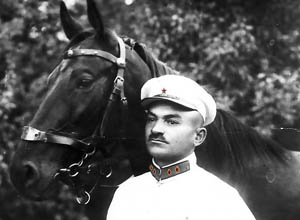
The Red Army intervention in Afghanistan in 1930 was a special operation of the Central Asian Military District command to destroy the Basmachi economic bases and exterminate their manpower in Afghanistan. The operation was carried out by parts of the combined cavalry brigade under the command of the brigade commander Yakov Melkumov.
References
- ↑ Ritter, William S (1990). "Revolt in the Mountains: Fuzail Maksum and the Occupation of Garm, Spring 1929". Journal of Contemporary History . 25: 547. doi:10.1177/002200949002500408.
- ↑ Ritter, William S (1985). "The Final Phase in the Liquidation of Anti-Soviet Resistance in Tadzhikistan: Ibrahim Bek and the Basmachi, 1924–31". Soviet Studies . 37 (4). doi:10.1080/09668138508411604.
| | This article related to Central Asian history is a stub. You can help Wikipedia by expanding it. |